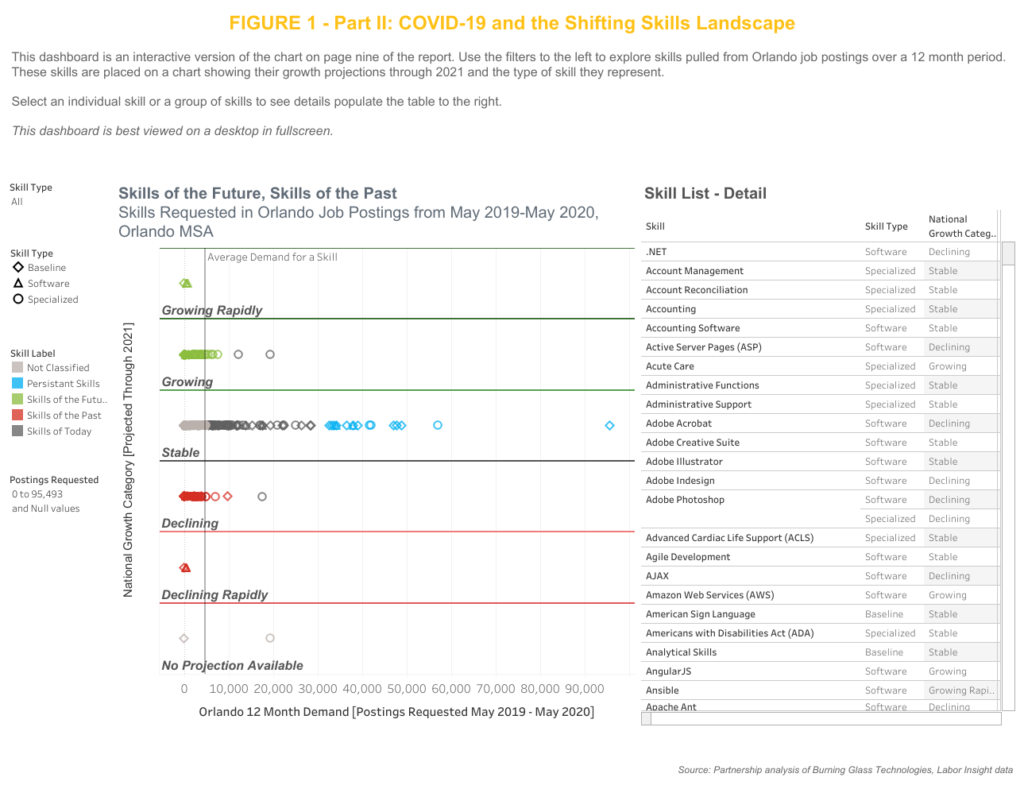The COVID-19 pandemic has changed the skills demanded of workers in a matter of months. Explore what the skills of the future look like and how they are signals of emerging workforce trends.
Automation, technology, and the fluctuating demands of employers have been changing the skills landscape for decades. The skills in demand today are not the skills that were required 10 years ago, nor will they be the skills necessary to perform cutting-edge work 10 years in the future. While new technologies may take years to be adopted and widely appear in job requirements, the COVID-19 pandemic has changed the skills demanded of workers in a matter of months.
In this second installment in a series of blogs based off of the new report by the Foundation for Orlando’s Future titled Re-Imagining Orlando’s Talent Supply: Skills-Based Hiring for Upward Mobility, we explore what the skills of the future look like and how they are signals of emerging workforce trends.
Download the Skills-Based Hiring Report today!
Skills of the Future, Skills of the Past
New data sources being pioneered by Burning Glass Technologies and EMSI use millions of company job postings from across the country to identify skills that are growing and declining in demand. Analytics and projections of skill demand at a national level inform what skills companies are beginning to search for on an increasing basis, or which skills are becoming irrelevant as consumer demand shifts and technology takes over more aspects of work.
In the framework below, we analyze the top skills requested in the Orlando Metropolitan Area (the four-county region of Lake, Orange, Osceola and Seminole) and compare their national growth projections from Burning Glass Technologies. This analysis reveals clusters of baseline, specialized and software skills that range from growing rapidly in demand to declining in general need. Click on the image below to access the interactive table where you can use your cursor to select groupings of skills and see more details about those skills.

The skills of the future are projected to grow in need and are clustered around the average demand in the Orlando MSA. The skills of the past are projected to decline despite a sometimes greater than average demand. Skills of today are in high demand and the majority have a stable growth projection. A few key skills have stable growth but extremely high demand, which have been labeled as persistent skills due to ubiquitous use in job postings.
Skills and Workforce Trends
Skills of the future include healthcare services that involve the intensive care of patients and planning for patient needs. This could be related to the spike in need for healthcare professionals to care for those infected by COVID-19 but is also an outcome of America’s changing demographics. The aging of the Baby Boomer generation is raising the national median age and increasing the need for caregiving and healthcare professionals, a trend now reflected in skill demand.
Software skills such as Python, Git, SAP, Salesforce and Scrum were growing quickly pre-pandemic and the need for them has only increased as work shifts to the remote and digital environments. This job posting data also shows signs of other skills that have become crucial in a pandemic environment, such as food safety protocols.
Other skills, defined as persistent skills, remind us of the core abilities employers are consistently seeking in their talent. These skills have stable growth projections and are widely requested across all occupation types and pay-levels.
For example, the persistent skills of sales, scheduling and customer service. One or more of these abilities was requested in more than one third (36 percent) of all job postings in the Orlando MSA over the last 12 months. Exactly 59 percent of these job posts request high school or vocational training, while 42 percent request a bachelor’s degree. The fact that these skills appear in jobs bifurcated so starkly by education level speaks to the high value they deliver for employers and potential for creating upward mobility pathways, defined here as career pathways that build on an individual’s existing skills and help her/him move into a higher-paying job.
Skills-Based Hiring
Skills-based hiring tactics focus on the importance of these persistent skills, rather than a candidate’s education level or industry of prior experience, creating hiring processes that benefit both the individual and employer. In the example above, the scheduling skills of an individual working in a job requiring a high school diploma are no less beneficial than in a job requiring a bachelor’s degree. Skills-based hiring tactics recognize this and help employers find the talent they need while creating more equitable hiring practices.
The Skills-Based Hiring report outlines the full list of growing and declining skills in greater detail as well as the specific benefits skills-based hiring offers employers. Visit Orlando.org/skillsbasedhiring to download the report. If your company has found success with changing hiring practices to be more skills-based or removing credential requirements in job postings, please contact Senior Director of Talent Initiatives for the Partnership, Danielle Permenter, so that we can share your story.





